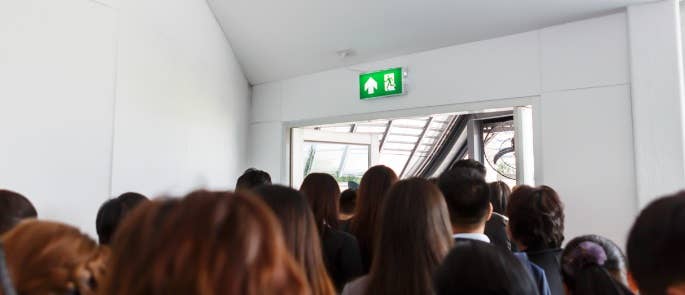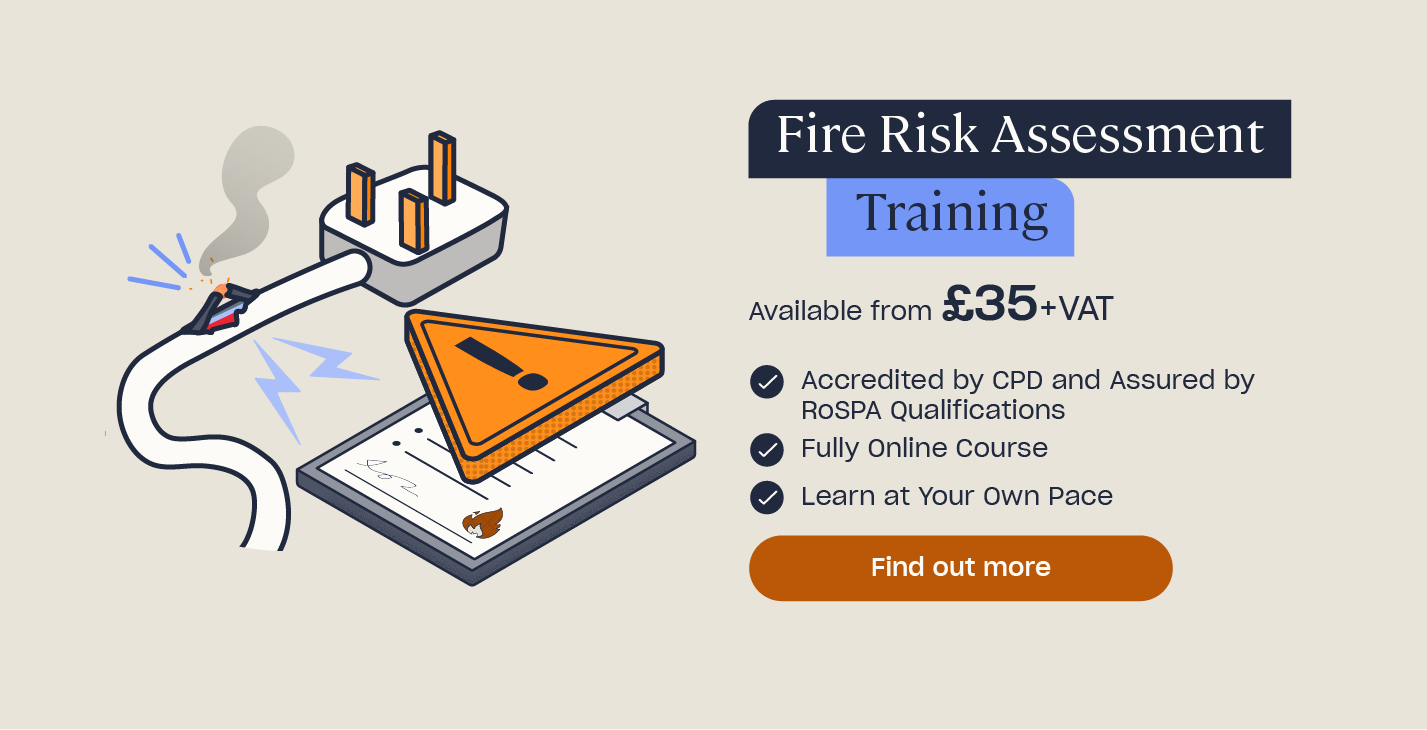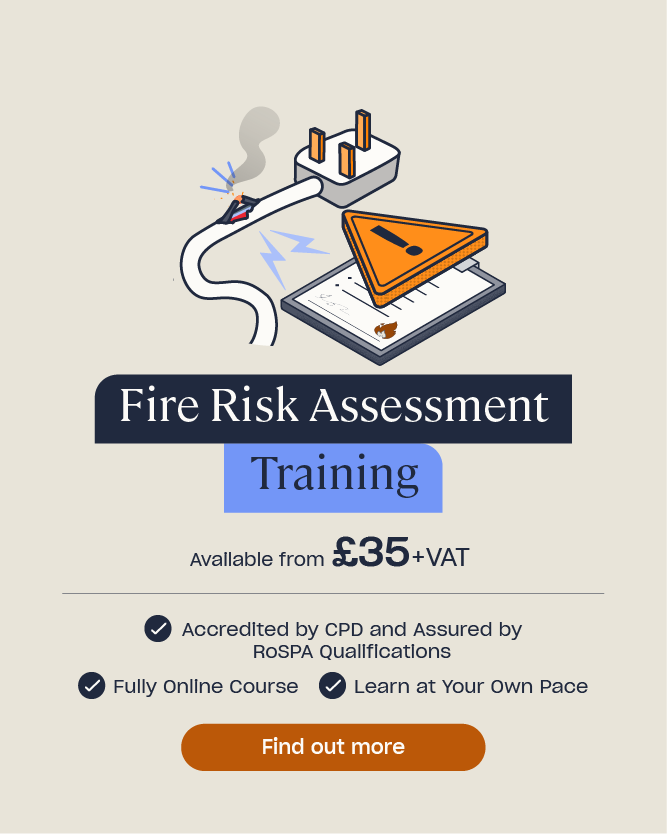Creating a Fire Safety Evacuation Plan for your Business
In the instance of a fire, a quick and safe evacuation of everyone in the building is of the utmost importance. Fire and smoke spread fast, and could leave people trapped in dangerous, inescapable locations if an evacuation plan is not in place. But as an employer, owner, manager, landlord, or occupier of a business or other non-domestic premises, you will ensure that no one is ever put in that position by preparing an effective and tested evacuation plan. You are known as the ‘responsible person’.
What Are My Duties as a Responsible Person?
As the responsible person, you must make arrangements for the event of a fire emergency – namely, an evacuation plan. When producing this, you must consider various factors relating to your workplace and the people within it, and one of the first steps to accomplish this is carrying out a fire risk assessment of your premises.
Doing so simply involves observing your workplace, identifying the risks, determining who may be harmed, implementing new safety measures in light of your findings, and reviewing and updating it on a regular basis. Once you have assessed the premises in this way, you can begin to consider what you need to include in your emergency plan.
If you have five or more employees, you must record your findings and your emergency plan.

What Should I Include in a Fire Evacuation Plan?
You should make the following arrangements when preparing your fire safety evacuation plan:
- A fire evacuation strategy – employees and fire wardens/marshals need to be aware of what actions they should take if they discover a fire.
- Alarm systems – decide how you will alert people if there is a fire, taking into account those who are hard of hearing or deaf.
- Escape routes – a clear explanation, clear signage, and visual representations where appropriate will instruct people on how to exit the building safely.
- Signage – there must be an ample supply of signs throughout the premises which show where safe routes for evacuation are. They should be luminous where needed.
- Emergency doors – any doors that are on the escape route must be easy to open, e.g. have a push bar (which should be accompanied by instructions on how to open it).
- Fire-fighting equipment – there should be plenty of fire extinguishers, of varying types where appropriate, around the workplace in easy-to-access locations.
- Fire alarm locations – in the event of a fire, the alarms must be raised immediately. People need to be aware of where the fire alarms are located so they can do so.
- Contacting the fire brigade or other emergency services – you should plan how they will be called and who will be responsible for doing so.
- Emergency lighting – where appropriate, such as in windowless stairwells, emergency lighting should be installed in case the power goes down.
- Any Personal Emergency Evacuation Plans (PEEPs) where needed – this is a plan tailored to accommodate people with vulnerabilities that may affect their ability to evacuate safely.
- Assembly point – you must inform everyone of where the assembly point is and instruct them to go only there in the event of a fire. A sign should indicate where it is.
- Procedures for roll call – when everyone is gathered at the assembly point, you must have a system for determining who is present and who may still be in the building.
Implementing all of these evacuation arrangements will ensure that people exit the building as quickly as possible, in an orderly fashion, and do so safely.
Need a Training Course?
Take a look at our Health and Safety course library where you’ll find everything from Fire Safety Training to Fire Warden Training.

Your evacuation plan must show that you have:
- Created clear, unobstructed passageways to all escape routes – corridors, doors, and staircases must not be blocked by any obstacles.
- Clearly marked the escape routes that lead to a safe location and ensured that they are as short and direct as possible.
- Created enough exits and exit routes through which all people in the premises can escape.
- Supplied emergency doors and emergency fire-fighting equipment that are easy to use and in accessible locations, as well as emergency lighting where needed.
- Trained all employees in what to do if a fire breaks out and informed them where all the escape routes are and where the assembly point is.
- Created a safe meeting point for all staff present in your building, located away from the premises.
- Designated a fire warden or marshal, whose duty will be monitoring fire safety at all times, actively following good fire safety practices, and taking action in the event of a fire to lead the evacuation.
What’s the Best Fire Evacuation Strategy?
That depends entirely upon the size and nature of your premises and the people within it. Generally speaking, there will be aspects of fire evacuation that apply to almost all premises, such as having designated persons taking responsibility during the event of a fire (fire wardens).
One thing that you must remember about fires is that they spread incredibly quickly, uncontrollably, and erratically. What appeared to be a clear exit two minutes ago could suddenly become completely inaccessible.
Part of the fire warden or marshal’s duty is scouting the escape route; they must determine that it is safe and free of smoke and/or fire before leading people onto it.
For example, if the warden or marshal identifies that a doorknob is hot or a stairwell is rapidly filling with smoke, they must lead employees to another route. It is their duty to make sure no one is attempting to use an escape route that has been compromised in terms of safety.
There are four types of fire evacuation strategies:
- Simultaneous evacuation.
- Vertical or horizontal phased evacuation.
- Staff alarm evacuation (silent alarm).
- Defend in place.
1. Simultaneous Evacuation
This will be the evacuation process that most premises can use, particularly those that are not very big and don’t have many floors. It involves everyone exiting the building, in response to the warning signal given when a fire has been discovered, by walking through the escape routes in a calm and orderly fashion.

2. Vertical or Horizontal Phased Evacuation
In buildings that are larger than most, more complex in terms of layout, and have multiple floors, a vertical phased evacuation will allow those who are at a more immediate risk to evacuate the premises first and temporary delay those who are not. It may be appropriate in these circumstances to start evacuating only the area closest to the fire and tell others to stand by.
Evacuation of the floor where the fire is situated would be done first and foremost, as well as the floor above it. Evacuating higher levels quickly is essential; people could become trapped as the fire continues to spread upwards.
Where a vertical phased evacuation strategy is required, the fire warning systems should be capable of emitting two distinctly different signals (warning and evacuation) or delivering voice messages.
A horizontal phased evacuation may be required in premises like hospitals and care homes, where fire resistant compartments are available or where treatment can continue to be delivered until the fire has been dealt with.
Both vertical and horizontal evacuations take time and are risky, so additional fire precautions may be required. This includes voice alarm systems, fire control points, compartmentation of the premises (using fire-resistant construction in certain areas), or having sprinklers in the building where appropriate.
3. Staff Alarm Evacuation (Silent Alarm)
There will be some cases where setting off a general alarm for immediate evacuation is not appropriate, such as in cinemas and theatres. This is due to the mass of people present and the need for staff to put pre-arranged plans for safe evacuation into action; overcrowding will disrupt the safe and effective evacuation of everyone in the premises.
In these circumstances, a ‘silent’ staff alarm should be given that only they are aware of (through the use of fire records, personal pagers, discreet sounders, or a coded phrase on a public address system, for example), which will alert them to conduct a phased evacuation and set off a more general alarm signal when ready. A general alarm may be activated automatically if manual initiation has not taken place within a pre-determined time.
4. Defend In Place
There will be special circumstances which require the occupants of the building to stay put and allow the fire brigade to extinguish the fire. This is particularly true of hospitals or nursing homes, where patients may be confined to their beds, are immobile, or are on life support.
Temporary relocation may take place if possible, but in the case of patients who are connected to life support and cannot be moved, a decision would have to be made about which option is best: stay or move. Because of how high-risk this strategy is, you should only plan to use it if you have sought the advice of a competent person and the fire/rescue services.
What About People With Disabilities?

Regardless of what strategy you decide to follow, you must always consider the individual needs of those with vulnerabilities, such as those who are confined to wheelchairs, who are hard of hearing or deaf, or are visually impaired or blind. A specially-tailored plan should be made for them where required, which is known as a Personal Emergency Evacuation Plan (PEEP).
What Should a Personal Emergency Evacuation Plan Cover?
A PEEP should ensure that those with vulnerabilities receive assistance from the point of raising the fire alarm to passing through the final exit of the building.
It will cover every aspect of emergency evacuation, including:
- The person’s difficulty or inability with understanding the emergency evacuation procedures, which could be remedied by the use of BSL, Braille, tapes, or large print.
- Their difficulty or inability with identifying signs that mark emergency exits and routes – the assistance of another person will help them evacuate the building without signs.
- Their difficulty or inability with hearing the fire alarm at work – the use of visual alarms or a vibrating pager will help notify those who are deaf or hard of hearing about a fire.
- Their difficulty or inability with using stairways in the event of an evacuation – the assistance of another person or having access ramps would be good solutions.
It can be useful for those who may require a PEEP in your workplace to fill in an Emergency Evacuation Assessment form (and to receive assistance if they are visually impaired or blind). This will enable you to make whatever particular arrangements are required for a person with disabilities so that they can evacuate safely in the instance of a fire.
The Dos and Don’ts of Fire Evacuation
When you discover a fire and are evacuating, keep these things in mind so that your and others’ safety aren’t compromised.
Do
- Raise the alarm by operating the nearest fire alarm call point.
- Ensure that any visitors on the premises are also escorted from the building.
- Evacuate to a safe location, i.e. the assembly point.
- Remain at the assembly point once you get there.
- Return to the building only if authorised to do so.
- If you are responsible for assisting a person with a PEEP, respond as required by following the actions in the plan.
Don’t
- Use the lift (unless it has been specially designated as a refuge or part of the emergency escape route).
- Run during the evacuation process; this causes panic and can lead to accidents which affect people’s escape and safety.
- Stop or return to collect personal belongings.
- Attempt to fight fires unless you are a trained personnel.
Remember: an evacuation procedure cannot be considered reliable unless you have determined that it works in practice. Carry out a fire drill to make sure that it is effective and everyone is fully familiar with what it entails. In doing so, you will guarantee that you’re fully prepared for the worst and that everyone is kept safe.
Further Resources:
- Top 10 Fire Safety Tips in the Workplace
- Fire Safety Rules and Regulations in the Workplace
- Fire Safety Duties & Responsibilities of a Fire Warden
- How Many Fire Wardens Does My Business Need?
- Fire Safety Quiz
- Hotel Fire Safety Guide for Managers
- Fire Risk Assessment Quiz
- Fire Warden Quiz
- Fire Safety Signs
- Fire Risk Assessment for the Hospitality Industry
- Fire Risk Assessment Training









